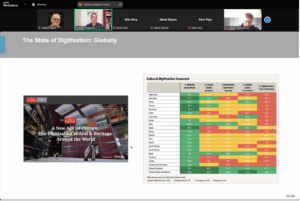 News
News
DIGHT-Net Workshop Report: “Creation of a Digital Archive” February 21, 2025
March 31, 2025
On February 21, 2025, the University of Turku (Finland) hosted the first DIGHT-Net event of the series of online workshops on New Trends in Digital Culture Studies, exploring various dimensions of digitality in relation to cultural heritage. The “Creation of a Digital Archive” workshop addressed the process of composing a digital archive from both global and grassroots perspectives, and compared the different implications of physical and digital archives. A diverse group of experts from academia and memory institutions across Europe, Asia, and the Americas attended the meeting. The questions and comments from approximately 80 participants enriched the workshop by providing additional perspectives. Petri Paju, Docent of Cultural History at the University of Turku, managed the online hosting and ensured the smooth flow of the event. You can watch the video recording of the event here.
Hannu Salmi, Professor of Cultural History at the University of Turku, inaugurated the event by outlining the DIGHT-Net project and its primary objectives. He discussed the core concepts of the workshop series and provided an overview of the upcoming workshops and twin lectures, which will focus on issues of equality and intersectionality, and sustainability of digital cultural heritage.
 The welcoming remarks were followed by two presentations. Gerben Zaagsma, Assistant Professor in Contemporary and Digital History at the Centre for Contemporary and Digital History (C²DH) at the University of Luxembourg, delivered the first presentation titled “The Digital Archive and the Politics of Digitisation”. He highlighted that archiving practices have evolved over time and that the digitisation of archives should be viewed within a broader historical continuum of collecting, organising, and microfilming materials. Zaagsma emphasised that the contemporary discourse on the sudden ‘abundance’ of digitised materials must be understood in its historical context. For historians, the use of digitised archival materials necessitates expanding traditional ‘source criticism’ to include tool, data, algorithm, code, interface, and digital source criticism. He also noted that despite the abundance of digital materials, significant gaps remain worldwide in the extent of digitised materials, and the politics and inequalities of heritage and preservation are often reflected in digital collections. The digitisation of cultural heritage materials continues to convey the effects of nationalism and global divisions between the North and South. Zaagsma further discussed the political dimensions of archiving, following the framework established by Brown and Brown in 1998.
The welcoming remarks were followed by two presentations. Gerben Zaagsma, Assistant Professor in Contemporary and Digital History at the Centre for Contemporary and Digital History (C²DH) at the University of Luxembourg, delivered the first presentation titled “The Digital Archive and the Politics of Digitisation”. He highlighted that archiving practices have evolved over time and that the digitisation of archives should be viewed within a broader historical continuum of collecting, organising, and microfilming materials. Zaagsma emphasised that the contemporary discourse on the sudden ‘abundance’ of digitised materials must be understood in its historical context. For historians, the use of digitised archival materials necessitates expanding traditional ‘source criticism’ to include tool, data, algorithm, code, interface, and digital source criticism. He also noted that despite the abundance of digital materials, significant gaps remain worldwide in the extent of digitised materials, and the politics and inequalities of heritage and preservation are often reflected in digital collections. The digitisation of cultural heritage materials continues to convey the effects of nationalism and global divisions between the North and South. Zaagsma further discussed the political dimensions of archiving, following the framework established by Brown and Brown in 1998.
The second presentation was given by Merit Maran, the Director of the Juri Lotman Semiotics Repository at Tallinn University. Her presentation, titled “Digitising Lotman: From Practice to Theory“, provided an overview of the digitisation process of the Juri Lotman and Zara Mints repositories. She illustrated how digitising collections located in two different premises, Tallinn University and the University of Tartu, can unify the collection and enhance accessibility. Her case demonstrated how both physical and digital formats influence the organisation of materials, revealing and concealing different aspects of the sources. Digitisation allows for the reorganisation of materials in new ways but also necessitates more detailed data descriptions. The contextualisation of materials within the collection is often lost or blurred during digitisation, as are sensory details such as texture, smell, and other physical cues. However, new forms of contextualisation, such as interlinking documents by the same author, date range, or location, become possible. The differing organisational principles of physical archives must be considered when creating metadata. Metadata can be generated by curators, users, and increasingly by machines, which can reveal new, previously unseen connections between digitised documents. Maran also addressed the need to balance accessibility with the ethical handling of personal information.
The presentations were followed by a panel discussion titled “Best Practices of Digitising Cultural Heritage.” The aim of the panel was to integrate the insights from Gerben Zaagsma and Merit Maran’s presentations in a discussion moderated by Mila Oiva, Docent of Cultural History at the University of Turku. The panel first addressed the importance of considering potential users when creating a digital archive. The Impresso project was highlighted as a successful example of engaging users early in the development of the digital archive interface. The panel also discussed how the use of Artificial Intelligence can be a valuable tool in the labor-intensive task of metadata creation. However, the rise of deep fakes necessitates careful consideration of how to ensure the authenticity of materials transformed from physical to digital formats. Additionally, the panel identified the next challenge in digitisation as the need to more tightly interlink different archives.
